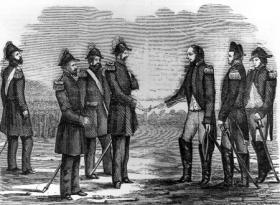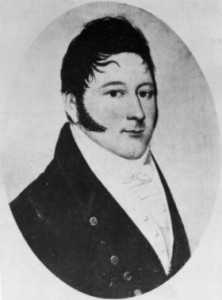‘Rescuing a complicated story from silence’: the Willcocks brothers, Joseph and Richard
Published in 18th–19th - Century History, Features, Issue 2 (March/April 2010), Volume 18
President and administrator of Upper Canada, Major-General Sir Isaac Brock (centre), accepts the surrender of American forces at Fort Detroit, 16 August 1812. Joseph Willcocks led legislative efforts to block Brock’s attempt to declare martial law in Upper Canada at the outbreak of the war, then reversed his position to become his right-hand man, serving with distinction at the battle of Queenston Heights, 13 October 1812, in which Brock was killed. (Canadian Illustrated News, c. 1863, and Government of Ontario Art Collection)
The History of the Irish Soldier by Brigadier Ted Bredin is dedicated to ‘all Irish soldiers who fought the good fight for the justice of their particular cause’. My great-great-great-uncle, Colonel Joseph Willcocks, who grew up in Dublin, does not appear in it. A Canadian magazine announced in 2008 that it was looking for Canadians ‘whose legacy is infamy’, and invited readers to nominate the ‘worst Canadian’ in the country’s past. As an example it cited Joseph Willcocks. Many Irish readers might look favourably on a man who emigrated to Canada and took sides with the Americans against the British, and less favourably on his brother, Richard, who stayed in Ireland, helped suppress the Emmett insurrection in 1803 and was later knighted.
Joseph Willcocks, ‘troublemaker’
Joseph had emigrated to Upper Canada (present-day south-eastern Ontario) in 1799 because the family was in financial difficulties. He went to York because he was promised land by his Uncle William and found employment managing Russell’s farm. When Russell fired him, his enemies found it in their interest to support Joseph. He was hired as clerk to the parliament and then made sheriff of the Home District (one of Upper Canada’s four districts). He established the first opposition newspaper, the Upper Canada Guardian, which was anti-Governor-General Gore though not anti-British, his politics becoming radicalised by events. Despite being popularly elected three times to the legislative assembly, he was fired and jailed for sedition. Joseph wrote:
‘I am flattered at being ranked among the enemies of the king’s servants in this colony. I glory in the distinction. Is it truth and a constant adherence to the interests of the country that has excited so much alarm among the band of sycophantic office hunters, pensioners and pimps.’
When the war of 1812 broke out between the United States and the UK and its colonies, Joseph found himself suspected by many who thought that he had taken part in the rebellion of 1798 against the British in Ireland. Gore thought that Joseph was plotting to overthrow the government and conspiring with the exiled former United Irish leader, Thomas Addis Emmet, later attorney general of New York State. A People’s History of Canada describes Joseph as ‘the leading critic of British military rule, who had been a troublemaker since the day he arrived from Ireland in 1799’ and ‘the uncontested leader of the unofficial opposition’.
Changes tack (twice)

Joseph’s older brother, Sir Richard Willcocks, magistrate and pioneer of modern policing. (Wellington County Archives, Ontario)
Joseph led legislative efforts to block Major-General Isaac Brock’s attempt to declare martial law in Upper Canada at the outbreak of the war, then reversed his position to become right-hand man to Canada’s military commander. He was sent as emissary to the Grand River Mohawk and brought them into line with the British cause. In 1812 Willcocks served with distinction as a volunteer at the battle of Queenston Heights, in which Brock was killed.
Joseph fell out with Brock’s successor, who stiffened colonial resistance to the American threat by punishing Canadian dissidents. In 1813 Joseph began corresponding with the American secretary of state, supplying information about British troop movements: ‘I do not hesitate to say that as soon as the British are driven out from amongst us I shall . . . with the assistance of my friends render this province independent of British influence’. Joseph defected and raised a force of expatriate Canadians calling themselves the Canadian Volunteers. The Americans made him a colonel as he led this band of 150 Canadians, including other members of the legislature, against Canada.
After the Americans invaded and burned York, Joseph led the forces that burned Newark, now Niagara-on-the-Lake. (Some historians speculate that this provoked the retaliatory burning by the British of the White House in Washington.) In 1814 Fort Erie was occupied by US forces under Joseph’s command and the battle of Fort Erie became a struggle by the British to drive out American forces. The Americans were defeated and Joseph was killed.
Richard Willcocks, magistrate and policeman
Meanwhile, back in Ireland, Joseph’s older brother Richard had led a different life. In 1803 he was involved as a magistrate in the suppression of the Emmet insurrection. According to Baron Hatherton, later chief secretary, he obtained and communicated to the government the first information of Emmet’s designs and thereby prevented the insurgents from taking Dublin. One book describes how he rose from his sickbed and laboured to convince sceptical government officials that even Dublin Castle was under threat: ‘He was determined at the expense of his life to be himself the bearer of a message to the Castle, by which, if he did not produce conviction in the minds of others, he would, at least, satisfy his own conscience’.
From 1807 to 1827 he saw service in different parts of Ireland and was sent from time to time into the counties of Kerry, Limerick, Tipperary, Cork, Waterford, Kilkenny, Meath and Westmeath. In 1814 (the year Richard’s brother Joseph was killed) Sir Robert Peel, chief secretary of Ireland, introduced in parliament the Peace Preservation Bill. He appointed Richard Willcocks chief magistrate to command the first detachment of the Peace Preservation Force (PPF) in the barony of Middlethird, Co. Tipperary, where in the previous three years there had been lawlessness connected with agrarian unrest. Even a political opponent, Lord Donoughmore, congratulated the government on their determination to exclude political considerations and make efficiency the sole test of appointments. These, the first paid policemen in Ireland, were soon known, particularly by nationalists, as ‘Peelers’.
By the end of September 1814 Peel wrote that the practical proof of the efficacy of the PPF was ‘that since the day on which Middlethird was proclaimed, I have not had the report of any outrage of any description either in that or in any other part of Tipperary, an extraordinary state of things in that county’. Galen Broeker (‘Robert Peel and the Peace Preservation Force’ in the Journal of Modern History, Vol.XXXIII, Dec. 1961, No.4) writes that it could possibly be said that Willcocks was Ireland’s first truly professional policeman: ‘Apparently he avoided serious political involvement, his attitude toward the lower classes seems to have been free of the hatred and fear felt by numbers of the local magistrates, and by the standards of contemporary political morality he was honest’. In a letter to the civil undersecretary, William Gregory, Richard wrote: ‘Magistrates of the highest respectability, Catholic and Protestant, are pledged, each to the other, and one and all, to support the laws, and bring to justice those who should offend against them’.
‘Ireland tranquilized’
![‘This [silver snuff] box was presented to Sir Richard Willcocks by William Smith, Thomas Doolan, Joseph A. Dames, Benjamin Jackson and William Doolan esq., Chief Constables in the County of Limerick Constabulary, as a small token of their respect and esteem on his retiring from the laborious duties of Inspector General of the Munster Constabulary, 1st March 1828.’ (PSNI Museum)](https://www.historyireland.com/wp-content/uploads/2013/02/77_small_1268933249.jpg)
‘This [silver snuff] box was presented to Sir Richard Willcocks by William Smith, Thomas Doolan, Joseph A. Dames, Benjamin Jackson and William Doolan esq., Chief Constables in the County of Limerick Constabulary, as a small token of their respect and esteem on his retiring from the laborious duties of Inspector General of the Munster Constabulary, 1st March 1828.’ (PSNI Museum)
‘The general prosperity of the empire begins to reach Ireland. Prices have improved, rents and even tithes are better paid, and in the districts which had been better paid, and in the districts in which people had been most disturbed the people are turning their attention to pursuits of industry and honest labour, instead of plotting or executing schemes of outrage and violence. In short I should have been able . . . to present the gratifying tribute of Ireland tranquillized to his majesty were not the general prosperity and happiness disturbed by the noisy fury of the Catholic Association.’
In 1826 Richard, who had by then been inspector general of the Munster constabulary for three years, reported to Wellesley on the ‘exceptional peace’ in Munster, and added that it was gratifying that this had not been effected by coercive measures ‘but gradually attained by legitimate causes’. In 1827, after resigning because of ill health, he was knighted for his services. Donal O’Sullivan, an authority on the Royal Irish Constabulary, wrote to me that ‘Major Willcocks was in many ways the real pioneer of modern policing’.
Last resting places
Sir Richard Willcocks lies in the family plot in the St Lawrence Church of Ireland cemetery. His epitaph reads: ‘Praises on tombs are trifles vainly spent; a man’s good name is his own monument’. The Cork Evening Herald described him as one of the most respected members of the county of Dublin magistracy: ‘He was in private life a most inestimable character, and in public, everything that activity, sound discrimination and honesty of purpose could make a man’.
His brother Joseph rests beneath flags in an unmarked grave at Fort Erie, Ontario. The Dictionary of Canadian Biography records that he opposed arbitrary and distant power, valued loyalty to his country rather than to its rulers, and believed in the independence of colonial legislatures. Canadian author John B. Lee, who has made a study of Joseph’s life, writes:
‘Vilified by Canadian history, championed as a hero by the United States, he was summarily forgotten. Perhaps we have vilified the wrong brother. He [Richard] died a gentleman honoured by the Crown yet despised by the Irish people. Let us honour the dead. Let us defy the liars and dignify his death by taking sides. Let us rescue even complicated stories from silence. Let us bring his face to the light.’ HI
Michael Henderson is a writer of English and Irish background.
Further reading:
N. Gash, Mr Secretary Peel—the life of Robert Peel to 1830 (London, 1961).
J. Herlihy, The Royal Irish Constabulary (Dublin, 1997).
J.B. Lee, King Joe: a matter of treason—the life and times of Joseph Willcocks(Norfolk County, 2010).
D. O’Sullivan, The Irish Constabularies, 1822–1922 (Dingle, 1999).
















